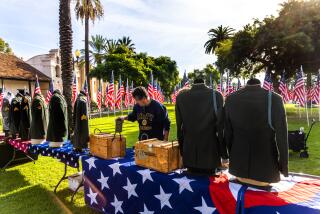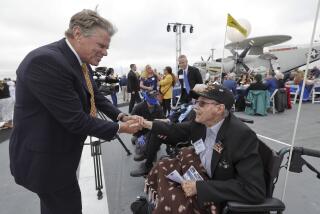Desert Site Near Indio Was Training Camp : Museum Hopes to Let Patton Ride Again
- Share via
CHIARICO SUMMIT, Calif. — Margit Chiarico Rusche remembers when George S. Patton came to her desert town 45 years ago and set up camp.
“There were tanks rumbling past for miles and miles and a whole sea of tents, everything very spiffy,” she says. “It wasn’t scary at all. It was exciting. We were part of history being made and we were on the winning side.”
If Rusche’s $1.7-million dream project comes off as scheduled, other folks can relive the exploits of the World War II hero when the Gen. George S. Patton Memorial Museum opens next November at the site of his old training center.
While progress on the official Richard M. Nixon and Ronald Reagan presidential libraries has been trumpeted, the proposed memorial for “Ol’ Blood and Guts” has been quietly attracting support through word of mouth.
Popularity Expected
Like the famed 3rd Army the general led, the Patton museum keeps forging ahead. And, given the enduring popularity of the Patton legend, the Chiarico Summit museum will likely become a tourist draw.
“Even before the George C. Scott movie, just the name ‘Patton’ stirred people,” she says.
“Americans love heroes and Patton was a born hero. We’ve gotten thousands of letters from people saying, ‘The museum is a great idea. It’s about time somebody did this.’ ”
A native of San Marino, Calif., Patton returned to his home state in 1942 to set up a desert training center for U.S. soldiers heading into combat in North Africa. After selecting the barren terrain of Chiarico Summit, 25 miles east of Indio, the general sought help from a local surveyor, who happened to be Rusche’s father.
General Asks for Help
“Patton came in and said to my father, ‘I hear you’ve been around here a while. I hope you can help me out,’ ” says Rusche.
Under the general’s direction, 11 separate camps were set up with Camp Young, Patton’s headquarters, as the focal point. Over the next two years, an estimated quarter-million soldiers prepared for battle at the training center before it closed down at the end of the war.
Many of those men, now in their 60s or older, have written Rusche to share their memories of the general and offer support.
“We’re trying to get oral histories from these men for a video display at the museum,” Rusche reports. Other museum exhibits, which will fill 5,760 square feet of interior space, will include a diorama of camp life with uniforms, cots and other artifacts and some of Patton’s personal items.
M-47 Tank Obtained
For outdoor display, the museum planning board has already snared a World War II M-47 tank from Patton’s Sicily campaign. Transporting the tank from an Alabama Army depot proved a challenge but luckily, Rusche reports, the general has fans in high places.
“President Reagan read about the tank and instructed Anne Kelley of the White House Office of Private Sector Initiatives to help us out,” she recalls. Offers of free railway and truck service came in shortly afterward.
Government intervention has been instrumental in getting the museum off the drawing board, Rusche says. The Bureau of Land Management’s Indio office helped procure the land and develop the site and the National Archives have promised to share “a wealth of photographs and other memorabilia,” she says.
Ford to Attend Opening
Former President Gerald R. Ford will attend the museum’s opening on Patton’s 103rd birthday next Nov. 11, Rusche reports, and letters of encouragement have come in from a host of celebrities, including Chrysler chairman Lee Iacocca and pioneer test pilot Chuck Yeager.
“Barry Goldwater, of course, was very thrilled about the project,” she says. “He has very fond memories of flying from Yuma to Camp Young to attend the end-of-the-day session where Patton would critique the day’s activities. He said these were among the fondest memories of his life.”
Personal Side Sought
Rusche says she hopes the museum, when completed, will help capture the personal side of Patton, who is at once one of America’s most controversial and most beloved military figures.
“There’s been a misconception that Patton glorified war,” she says. “I don’t think that’s true.” She says she thinks he felt war sometimes was the only means to gain peace.
“We want to show the other side of Patton. My dad said he really looked out for the civilians around the camp and if any of his troops did anything wrong, he saw that it was corrected immediately.”
For Rusche and the other civilians working on the Patton museum, she says, “this is one of the greatest missions ever. I think Patton would appreciate that everything that could possibly be put in our way has been put in our way and we’re going to build this museum anyway.”
More to Read
Sign up for Essential California
The most important California stories and recommendations in your inbox every morning.
You may occasionally receive promotional content from the Los Angeles Times.










